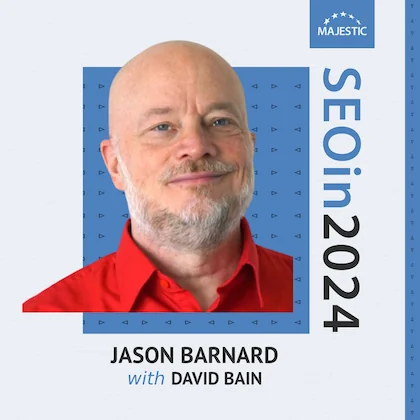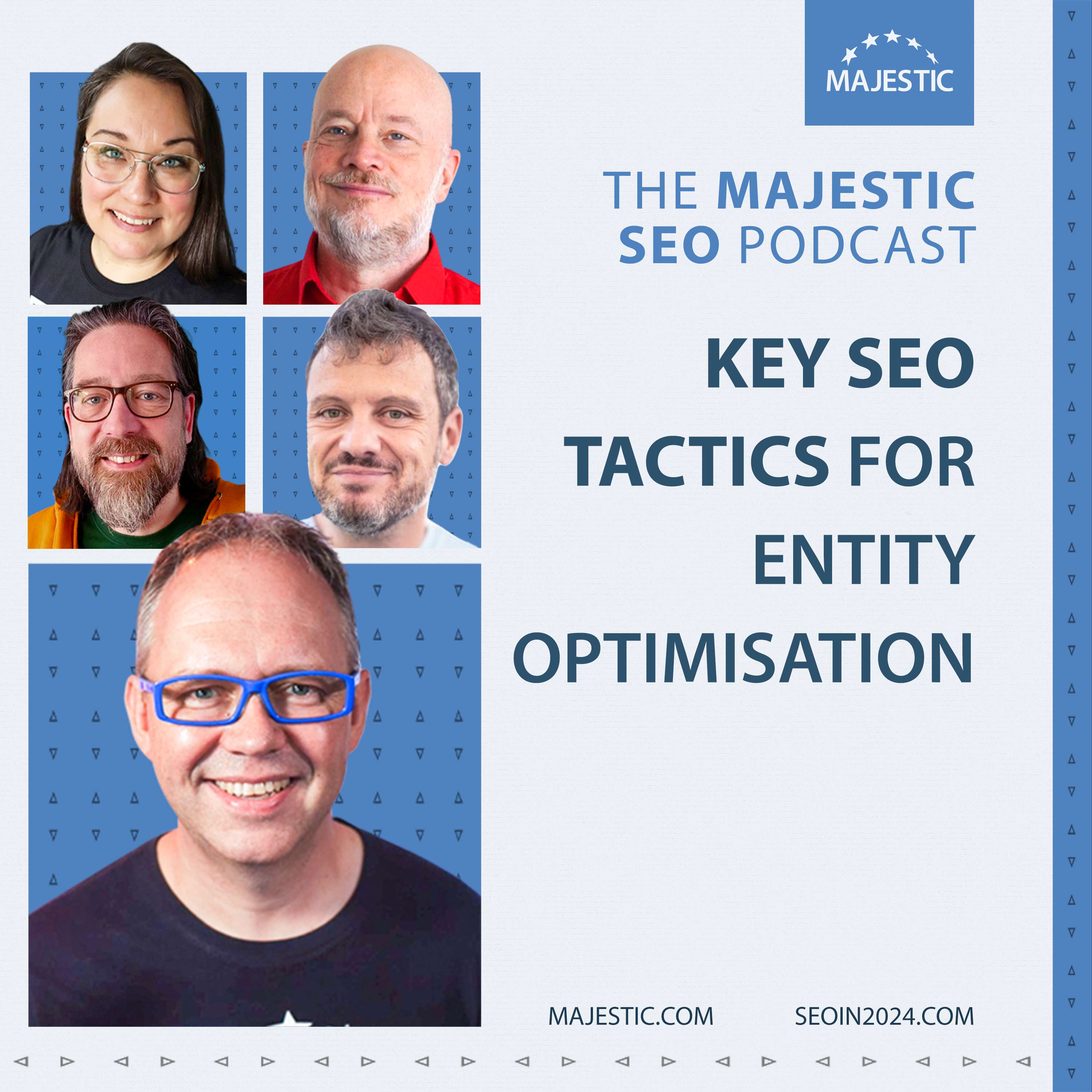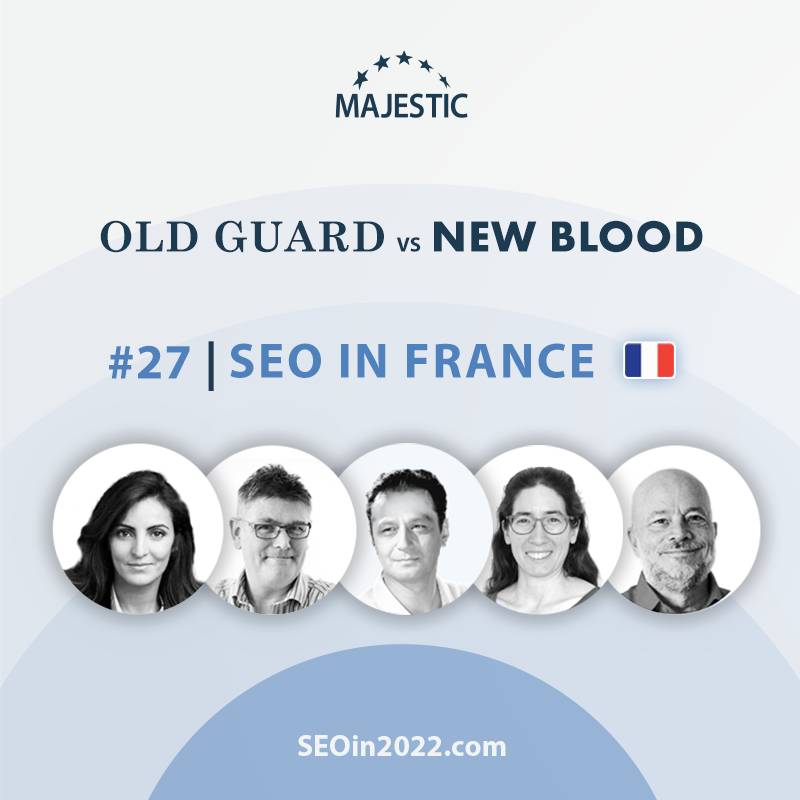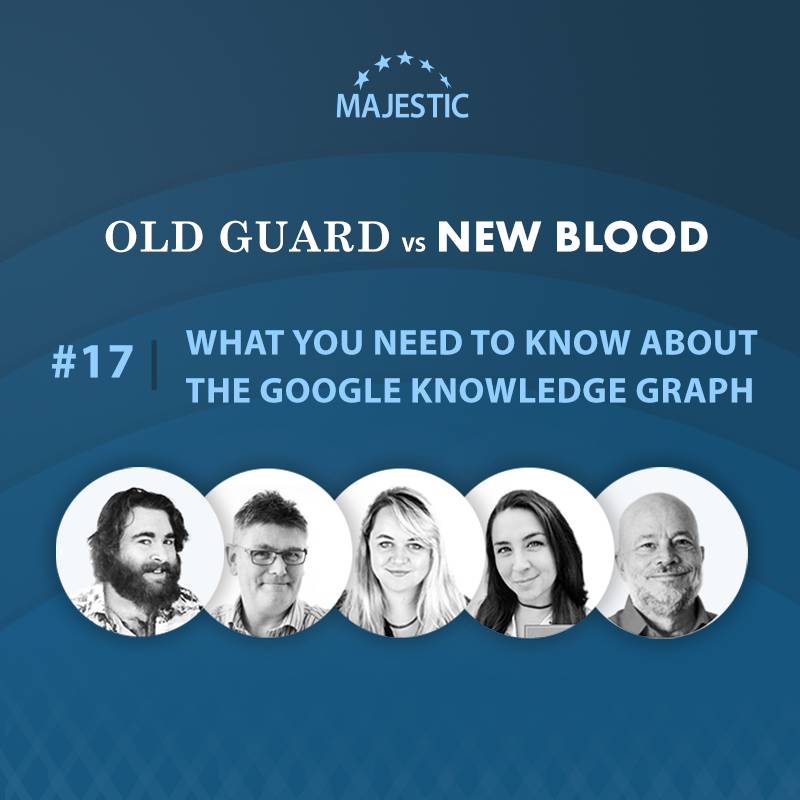-
Site Explorer
- Majestic
- Summary
- Ref Domains
- Backlinks
 New
New Lost
Lost- Context
- Anchor Text
- Pages
- Topics
- Link Graph
- Related Sites
- Advanced Tools
- Author ExplorerBeta
- Summary
- Similar Profiles
- Profile Backlinks
- Attributions
- Compare
-
Link Tools
- My Majestic
- Recent Activity
- Reports
- Campaigns
- Verified Domains
- OpenApps
- API Keys
- Keywords
- Keyword Generator
- Keyword Checker
- Search Explorer
- Link Tools
- Bulk Backlinks
- Neighbourhood Checker
- Submit URLs
- Experimental
- Index Merger
- Link Profile Fight
- Mutual Links
- Solo Links
- PDF Report
- Typo Domain
- Free SEO Tools
- Support
Learn how to tackle generative AI in search
Jason Barnard
Jason Barnard from Kalicube is focussed on another side to the technological capabilities of AI. He delves into the ways that generative AI is also impacting search results, and what to do about it.

Learn how to tackle generative AI in search
Jason says: “I have lots of tips about generative AI in search, Google’s search generative experience, and Bing Chat.
Interestingly enough, there isn’t much difference between Google and Bing when it comes to generative search. It mainly comes down to presentation, but they both function in more or less the same way.
A few months ago, Gary Illyes said that most search engines rank results in much the same way. That remains true today. What we can learn from Bing, we can mostly apply to Google as well.”
How do SEOs prepare for generative AI?
“First, we need to understand what generative AI is and how it works. In Google’s case, generative AI is simply a summary of its knowledge and recommendations. It takes the SERP, the knowledge panel, and the recommendations on the left, and summarises all of that to save the user the time of jumping between multiple websites to gather the information themselves. It’s a dynamic knowledge panel.
To understand how the search generative experience is going to work, you need to understand how Google and Bing are summarising their SERPs and what follow-up questions they suggest to keep the conversation going. The purpose of this, as Fabrice Canel from Bing pointed out to me, is to bring the user down the funnel to the point where they’re ready to buy. At that point, they send the user to the website.”
What elements are missing from the current knowledge panel that will feature on the next-generation knowledge panel?
“The current knowledge panel is a statement of facts. Google is saying, ‘These are the facts I’ve understood. Here’s a description that I’m confident is true. Here are the related entities and people also search for… Here are the social media platforms this person/company is on.’ It gives you a summary of the person or the company.
The search generative experience does that on the fly, instead of pulling it all out of the knowledge graph, and also offers you the opportunity for a conversation. It’s a conversational dynamic knowledge panel.”
How do you control that conversation with the user?
“You need to make sure that Google and Bing understand your funnel, and how to bring your audience down that funnel through their SERP. You need to educate these machines about who you are, what you do, which audience you serve, and what your funnel looks like so that they can replicate it on the SERP.
It feels like you’re giving control away to Google and Bing because you are. It doesn’t feel fair, but you can’t change how they’re going to evolve. We’re going to have to bite the bullet and do it. Ensure that the funnel they recreate on the SERP is the same as, or as close as possible to, the one that you have on your website and within your organisation.”
Should you adjust your funnel for generative AI?
“We’ve found that this process is hugely helpful for our clients. As soon as I ask them what their funnel is, how it works, and what questions people ask as they go down, the business will struggle to explain it. They are never very clear about their own funnel.
This forces people to identify what their funnel looks like, what the questions are, and who the personas are – and then lay it out on the website in an easily digestible manner. That’s helpful for users who come to their website from another platform (Facebook, Twitter/X, Medium, etc.), but it also helps the search engines understand that funnel so they can guide their assistive engines to bring that user down the funnel.
Don’t forget that users on Google are Google’s users. They might be your audience but, when they’re using Google, they are Google’s users. Google is recommending you to the subset of its users who are your audience.
This new experience forces brands and companies to create the content that their audience needs and wants, in the funnel and post-funnel, and set it out clearly on their website.”
What does the process for educating search engines about your funnel look like?
“It can include the use of breadcrumbs, better internal linking, navigational headlines throughout the funnel, and schema. However, the biggest chunk of the work is in your FAQ. It should have one question and answer per page, with simple answers to simple questions, and it should cover every single question your audience might be asking.
You also need to include FAQ schema markup, not for rich snippets in the SERP but to make sure that Google is confident it has understood the content. Google’s given us the carrot of stars or accordions in the SERP, but schema markup is really there to translate what you’re saying on the page into Google’s native language. Schema is Google and Bing’s native language. The role of Schema is to reassure the machine that it’s fully understood what it’s seen on the page. Schema markup is supporting evidence; it’s reassurance and it’s confidence-building in the content you’ve got.
I will bet my bottom dollar that your FAQ is way too small right now, and it doesn’t even answer 5% of the questions that people ask on the way down the funnel or post-funnel.”
Can you format your FAQ pages to indicate which stage of the funnel the question relates to?
“Yes. Within the FAQ, you can clearly describe where you feel the user is in the funnel by the way that you word what you’re saying. Are you talking to somebody who hardly knows who you are, somebody who knows who you are and is ready to buy, or somebody who’s already bought?
At Kalicube, we’re integrating FAQs into our process with every single client. The Kalicube process is to create knowledge and understanding in Google’s brain and make sure that the recommendations about the company are relevant and helpful to your audience. Together, those two elements will feed into generative AI, as long as we’re answering all the questions down the funnel.
Our process nails knowledge, recommendations, and Google’s summary of its own results – i.e., its assessment and judgment of the SERP. If you’re a brand, that’s hugely important. What does Google truly think of you? That’s what it will produce for your branded search with generative AI.”
Would you break up your FAQ with headings/subheadings?
“You’re not going to have a lot of headings because you should be giving a short, succinct answer to a simple question.
If you search for ‘plugin for multiple authors on a WordPress blog’, you’ll see results like, ‘Do you want to create multiple authors on a WordPress blog?’ and ‘What is the technical implication of creating multiple authors on a WordPress blog?’ However, you just want to know how to do it. You don’t want all that introductory information that SEOs have created for context. You already know what you want; you want the simple answer to the simple question, ‘What plugin do I need?’
From that perspective, FAQs should be short – and they can be as short as 100 words. I’ve ranked FAQs for a tiny French company above Apple with just 100 words. The trick is to categorise correctly. Each stage of your funnel should be in a specific category that has a descriptive name that makes sense to your users.
I would also suggest having two main categories: one for branded questions and one for generic questions about your topic. Then, you can build them out with multiple categories, making sure that you identify every category at the beginning so that it’s infinitely scalable. If you’re thinking ahead, you should never be answering a question that does not fit into one of the categories that you created right at the start.”
In 2024, should you bin the blog and have an evolving FAQ section instead?
“I wouldn’t bin the blog, but I would focus on the FAQ – at least for 2023-2024. The blog has its own role. If I want a quick answer to a simple question, I need 100/200 words. If I want to delve into a topic, I need 1,000/2,000 words. That’s a blog. If I really want to dig into a topic, I’ll buy a book or download a PDF white paper that’s 8,000 words. At Kalicube, we’ve got FAQs, blogs, white papers, and books.”
Is generative AI going to kill SEO?
“No, but SEOs are going to have to adapt. You need to create a digital marketing strategy that covers all of the different channels where your users hang out. You need to stand where the audience is looking (Facebook, Medium, LinkedIn, Forbes.com, etc.), package your content on those platforms for Google, and create content that helps Google and Bing to bring your audience down your funnel, on their platform, and buy.
There’s an enormous amount of SEO work to do, but SEOs are going to have to learn that the job is no longer standalone. By necessity, it’s part of a wider digital marketing strategy. In my opinion, SEO is simply packaging great branding and great marketing for Google and Bing.”
Do you need to be everywhere all at once?
“You don’t have to be everywhere; you have to be where your audience is looking. At Kalicube Pro, we analyse your digital ecosystem and your market’s digital footprint so we can identify where your audience is hanging out. Then, we can focus your marketing efforts on the platforms that make sense to your audience and ensure that you’re creating the right content that helps your audience understand you have the solution to their problem.
You need to stand where they’re looking, show them you have the solution to their problem, and then tell them what to do next.”
How do you know whether or not to use a platform?
“In Kalicube Pro, you can look at the market template. If Facebook is dominating your market, you focus on Facebook. If LinkedIn is dominating your market, you focus on LinkedIn.
We prioritise it. We will give you six major platforms that you could potentially focus on and you can say, ‘I don’t have the team to do that, let’s just focus on the top three.’ You need to do each job properly, so it’s better to focus heavily on three platforms than do a bad job on six. It’s obviously even worse to do a bad job on ten. I can’t imagine any company needing to be on ten different platforms.
We have lots of free tools on Kalicube Pro so you can have a general look at which platforms are dominating. The most basic way of doing this yourself is to use your human intuition and intelligence. Search your own brand name and look at which platforms come up on pages one, two, and three. Then, search your competitors and just look at page one. Look at the correlation and correspondence between them.
By looking at 20 competitors, you’ll probably see repetition, where one platform is dominating. That will be the platform to focus on because that is what Google perceives to be the most valuable platform for the majority of your market.”
If an SEO is struggling for time, what should they stop doing right now so they can spend more time doing what you suggest in 2024?
“If you consider that Google and Bing are going to keep the user on the SERP for longer, and bring them down the funnel, site speed and page speed become less important.
From an SEO perspective, page speed is significantly less important in a generative AI world, but site speed remains important for your users. From an SEO perspective, push site speed down in priority. However, from a user perspective, bear in mind that your users do need a fast site.
Focus on cornerstone entities instead: the Corporation Entities (website owner) and the Person Entities (content creator, author and CEO). This is the key to maximizing the effect of the EEAT credibility signals which, in turn, is key to appearing in Generative AI search results on Google, Bing, Bard, ChatGPT et al.”
Jason Barnard is CEO of Kalicube, and you can find him over at Kalicube.com.
Also with Jason Barnard
Choose Your Own Learning Style
 Video
Video
If you like to get up-close with your favourite SEO experts, these one-to-one interviews might just be for you.
Watch all of our episodes, FREE, on our dedicated SEO in 2024 playlist.
 Podcast
Podcast
Maybe you are more of a listener than a watcher, or prefer to learn while you commute.
SEO in 2024 is available now via all the usual podcast platforms
Don't miss out
Opt-in to receive email updates.
It's the fastest way to find out more about SEO in 2025.
Could we improve this page for you? Please tell us










